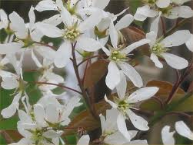June berries, Amelanchier
Having a mix of different varities of juneberry ensures a longer fruiting season. Some of the nicest varieties, according to Ken Fern in his Plants for a future book, are these:
Juneberry, Amelanchier lamarckii

These Juneberries have very tasty fruit in July. Sweet and succulent with a flavour of apples, they can also be dried for later use. This is one of the nicest fruits in the genus, they can be eaten and enjoyed in quantity. The fruit is rich in iron and copper. It is up to 10mm in diameter.
The trees grow up to about 6m tall.
Juneberry, Amelanchier canadensis
(This variety looks the same as lamarckii above)
The fruit contains a few small seeds at the centre, it has a sweet flavour with a hint of apple. It can be eaten out of hand, used in pies, preserves etc or dried and used like raisins. The fruit can be of variable quality, with some forms having a distinct bitterness in the flavour whilst others are sweet, juicy and delicious. When the fruit is thoroughly cooked in puddings or pies the seed imparts an almond flavour to the food.
The fruit is rich in iron and copper. It is about 10mm in diameter.
Trees can yield 7 to 15 tonnes per hectare.
A tea made from the root bark (mixed with other unspecified herbs) was used as a tonic in the treatment of excessive menstrual bleeding and also to treat diarrhoea. A bath of the bark tea was used on children with worms.
Saskatoon, Amelanchier alnifolia
Edible fruit, ra
w or cooked. The fruit ripens in mid summer (early July in southern Britain), it is soft and juicy with a few small seeds in the centre. A very nice sweet flavour that is enjoyed by almost everyone who tries it, there is a hint of apple in the taste. About the size of a blackcurrant, the fruit is produced in small clusters and the best wild forms can be 15mm in diameter.
The fruit can also be dried and used as raisins.
The fruit is rich in iron and copper.
The leaves are a tea substitute.
Young branches can be twisted to make a rope.
The wood is hard, straight grained, tough. Used for tool handles etc. The wood can be made even harder by heating it over a fire and it is easily moulded whilst still hot.
The young stems are used to make rims, handles and as a stiffening in basket making.
This variety only grows up to about 2m.
